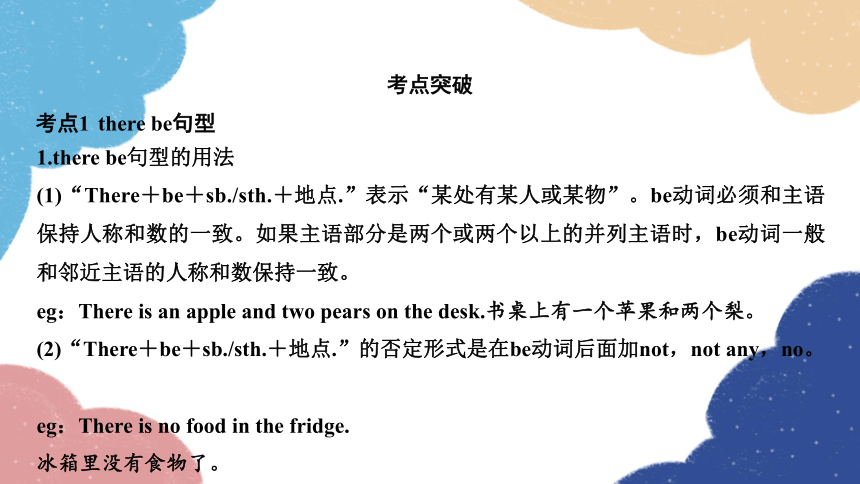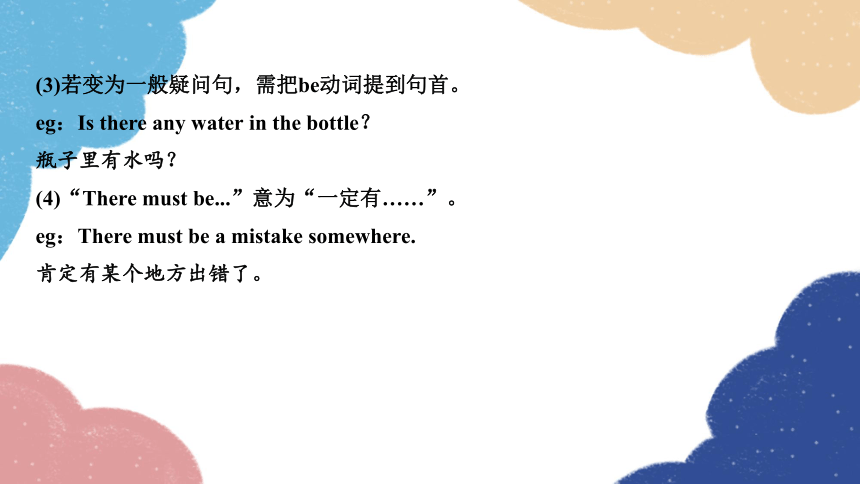2023年中考英语二轮复习 第十课时 there be句型和主谓一致课件(23张PPT)
文档属性
| 名称 | 2023年中考英语二轮复习 第十课时 there be句型和主谓一致课件(23张PPT) |  | |
| 格式 | pptx | ||
| 文件大小 | 415.5KB | ||
| 资源类型 | 教案 | ||
| 版本资源 | 人教新目标(Go for it)版 | ||
| 科目 | 英语 | ||
| 更新时间 | 2023-05-26 08:46:51 | ||
图片预览









文档简介
(共23张PPT)
第十课时 there be句型和主谓一致
第二章
考点突破
考点1 there be句型
1.there be句型的用法
(1)“There+be+sb./sth.+地点.”表示“某处有某人或某物”。be动词必须和主语保持人称和数的一致。如果主语部分是两个或两个以上的并列主语时,be动词一般和邻近主语的人称和数保持一致。
eg:There is an apple and two pears on the desk.书桌上有一个苹果和两个梨。
(2)“There+be+sb./sth.+地点.”的否定形式是在be动词后面加not,not any,no。
eg:There is no food in the fridge.
冰箱里没有食物了。
(3)若变为一般疑问句,需把be动词提到句首。
eg:Is there any water in the bottle?
瓶子里有水吗?
(4)“There must be...”意为“一定有……”。
eg:There must be a mistake somewhere.
肯定有某个地方出错了。
2.there be句型的时态
(1)“There will/is going to be...”意为“将会有……”。
eg:There will/is going to be a football match in our school next week.
下周我们学校将会举行一场足球比赛。
(2)“There used to be...”意为“过去有……”。
eg:There used to be lots of restaurants on the street.
这条街道上过去有许多家餐馆。
(3)“There have been...”意为“已经有……”。
eg:There have been a lot of accidents around here.在这一带已经发生了多起事故。
( B )①(2020·恩施州)There only a few things in the room,like a bed,some chairs and an old desk.
A.was B.were C.is
B
②(2019·鄂州)There are some boys swimming (swim) in the river now.It’s very dangerous.
swimming
考点2 主谓一致
主谓一致是指谓语动词与主语在人称和数上保持一致。因此,找出句子的真正主语是关键。同时,要遵循三个原则:语法一致原则、意义一致原则和就近原则。
1.语法一致原则
语法一致即主语是单数形式时,谓语动词就用单数形式;主语是复数形式时,谓语动词就用复数形式。
(1)单数可数名词和不可数名词作主语时,谓语动词用单数形式;可数名词复数作主语时,谓语动词用复数形式。
eg:The water in this lake is clean.
这个湖里的水很干净。
(2)如果名词(或代词)后有(together) with或as well as 开头的短语,只看该名词(或代词)的数。
eg:Li Ming with his classmates often goes to see a film on Sundays.李明和他的同班同学经常周日去看电影。
(3)有些名词看似复数形式,但实际上表示的是单数意义,谓语动词要用单数形式,如news(消息),politics(政治),physics(物理)等。
eg:Physics is very hard to learn well for me.对我来说学好物理非常难。
(4)像trousers,scissors,glasses这样的词总是以复数形式出现。当它们以单数形式出现或被a/this/that pair of修饰时,谓语动词用单数形式;当它们被two/three...pairs of修饰时,谓语动词用复数形式。
eg:A pair of glasses costs quite a lot now.
现在的眼镜很贵。
(5)用and连接的名词通常是指不同的人或物,谓语动词用复数形式,但有时用and连接的名词表示同一个人或物,谓语动词用单数形式。
eg:The composer and the singer of the song are here now.(两个人,and前后用了两个冠词)
这首歌的作曲者和演唱者现在都在这里。
The composer and singer is very famous.(一个人,and前后只用了一个冠词)这位作曲家兼歌唱家非常著名。
(6)不定代词either,neither,anybody,anyone,anything,someone,somebody,something,everyone,everybody,everything,nobody,no one,nothing等作主语时,谓语动词用单数形式。
eg:Is there anything wrong with your bike?你的自行车有什么问题吗?
Everyone is ready for the sports meeting.大家都为运动会做好了准备。
(7)“分数+of+不可数名词”作主语时,谓语动词用单数形式;“分数+of+可数名词复数”作主语时,谓语动词用复数形式。
eg:Nearly three fourths of the surface of the earth is covered by water.
地球表面近四分之三被水覆盖。
Two thirds of the students in this college are girls.这所学院三分之二的学生是女生。
( C )①Mathematics the language of science.
A.are B.are going to be
C.is D.is to be
C
( D )②At last he told me the news that known to all.
A.is B.are C.were D.was
D
2.意义一致原则
(1)集体名词被看成整体时,谓语动词用单数形式;集体名词指其成员或组成部分时,谓语动词用复数形式。常见的有class,family,police等。
eg:My family is a big one.
我的家庭是个大家庭。
My family are all watching TV.
我的家人都在看电视。
(2)一段时间、一笔钱、一段距离、算式等看成单数,谓语动词用单数形式。
eg:Five dollars is what I have now.
我现在只有五美元。
( D )①The police the murderer everywhere when he suddenly appeared in a theater.
A.is searching for B.was searching for
C.are searching for D.Were searching for
D
( A )②Ten minutes an hour when one is waiting for a phone call.
A.seems B.seem
C.seemed D.seeming
A
3.就近原则
(1)there/here be句型(there/here是引导词,没有实际意义,主语是be动词后的名词或代词),谓语动词的数要由离它最近的名词(或代词)决定。
eg:There is a pen and two books on the desk.书桌上有一支钢笔和两本书。
There are two books and a pen on the desk.书桌上有两本书和一支钢笔。
(2)用either...or...,neither...nor...,not only...but also...等连接的名词(或代词)充当主语时,谓语动词的数也是由离它最近的名词(或代词)决定。
eg:Neither Tom nor his classmates are from England.
Tom和他的同班同学都不是来自英国。
( A )①Look!There playing with the tourists on Dahe Square.
A.Are a number of deer
B.are a number of deers
C.is a number of deer
D.are the number of deer
A
( A )②Neither Jack nor I interested in playing computer games.
A.am B.is C.are D.were
A
1.“the+形容词”表示一类人或者事物,看成复数。
eg:The rich don’t always feel happier than the poor.有钱人不是总比穷人感觉更快乐。
2.“the+姓氏的复数形式”表示“姓……的一家人或夫妇两人”,看成复数。
eg:The Chens are very friendly to me.
陈姓一家人对我很友好。
3.名词所有格(或名词性物主代词)单独使用,表示复数意义看成复数,表示单数意义看成单数。
eg:My trousers are black,while Tom’s are blue.我的裤子是黑色的,但Tom的是蓝色的。
His father is a teacher,but Jim’s is not.
他的爸爸是一名教师,但Jim的爸爸不是。
4.动词-ing形式和不定式作主语,谓语动词用单数形式。
eg:Talking to people from other parts of the world is a good way to learn geography.
和来自世界其他地方的人交谈是学习地理的好方法。
To see is to believe.眼见为实。
5.主语从句一律看成单数。
eg:When he will go to visit Beijing has not been decided.
他还没有决定什么时候去游览北京。
Whether he will go there with us is not important.
他是否和我们一起去那里并不重要。
备考演练
一、词汇运用
1.(2020·上海)Nowadays,many robots (robot)have been used to work in dangerous situations.
2.(2018·兰州一模)I don’t think learning English is (be) difficult.
3.(2018·兰州一模)Nobody but Jim and John is (be) listening to the teacher now.
4.The singer and writer is (be) coming this way now.
5.(2022·日照)Make sure there are no mistakes (错误) in your test paper before handing it in.
robots
is
is
is
mistakes
二、单项选择
( C )1.(2022·柳州)Everyone here.Let’s go.
A.am B.are C.is
( D )2.(2019·天水) of the students in our class going to the summer camp in Beijing next week.
A.Two fifths;is
B.Second fifths;are
C.Second fifths;is
D.Two fifths;are
C
D
( C )3.(2019·南通)—What do you think of yesterday’s activity in your community?
—Wonderful.A lot of useful advice on self protection .
A.is offered B.are offered
C.was offered D.were offered
( C )4.(2020·齐齐哈尔)To avoid gathering(聚集),neither the students nor their head teacher going to the party this evening.
A.was B.are C.is
C
C
( A )5.(2018·铜仁)She with her mother often hills on Sundays.
A.climbs B.climb
C.climbed D.to climb
( D )6.(2018·新疆)Both Mike and I ready for the new high school life.
A.be B.am
C.is D.are
( A )7.(2019·天水)Either the students or the teacher him very well.
A.knows B.to know
C.know D.knew
A
D
A
( B )8.(2022·毕节)Neither Saturday nor Sunday OK because I will be quite busy these two days.
A.are B.is
C.am D.be
B
第十课时 there be句型和主谓一致
第二章
考点突破
考点1 there be句型
1.there be句型的用法
(1)“There+be+sb./sth.+地点.”表示“某处有某人或某物”。be动词必须和主语保持人称和数的一致。如果主语部分是两个或两个以上的并列主语时,be动词一般和邻近主语的人称和数保持一致。
eg:There is an apple and two pears on the desk.书桌上有一个苹果和两个梨。
(2)“There+be+sb./sth.+地点.”的否定形式是在be动词后面加not,not any,no。
eg:There is no food in the fridge.
冰箱里没有食物了。
(3)若变为一般疑问句,需把be动词提到句首。
eg:Is there any water in the bottle?
瓶子里有水吗?
(4)“There must be...”意为“一定有……”。
eg:There must be a mistake somewhere.
肯定有某个地方出错了。
2.there be句型的时态
(1)“There will/is going to be...”意为“将会有……”。
eg:There will/is going to be a football match in our school next week.
下周我们学校将会举行一场足球比赛。
(2)“There used to be...”意为“过去有……”。
eg:There used to be lots of restaurants on the street.
这条街道上过去有许多家餐馆。
(3)“There have been...”意为“已经有……”。
eg:There have been a lot of accidents around here.在这一带已经发生了多起事故。
( B )①(2020·恩施州)There only a few things in the room,like a bed,some chairs and an old desk.
A.was B.were C.is
B
②(2019·鄂州)There are some boys swimming (swim) in the river now.It’s very dangerous.
swimming
考点2 主谓一致
主谓一致是指谓语动词与主语在人称和数上保持一致。因此,找出句子的真正主语是关键。同时,要遵循三个原则:语法一致原则、意义一致原则和就近原则。
1.语法一致原则
语法一致即主语是单数形式时,谓语动词就用单数形式;主语是复数形式时,谓语动词就用复数形式。
(1)单数可数名词和不可数名词作主语时,谓语动词用单数形式;可数名词复数作主语时,谓语动词用复数形式。
eg:The water in this lake is clean.
这个湖里的水很干净。
(2)如果名词(或代词)后有(together) with或as well as 开头的短语,只看该名词(或代词)的数。
eg:Li Ming with his classmates often goes to see a film on Sundays.李明和他的同班同学经常周日去看电影。
(3)有些名词看似复数形式,但实际上表示的是单数意义,谓语动词要用单数形式,如news(消息),politics(政治),physics(物理)等。
eg:Physics is very hard to learn well for me.对我来说学好物理非常难。
(4)像trousers,scissors,glasses这样的词总是以复数形式出现。当它们以单数形式出现或被a/this/that pair of修饰时,谓语动词用单数形式;当它们被two/three...pairs of修饰时,谓语动词用复数形式。
eg:A pair of glasses costs quite a lot now.
现在的眼镜很贵。
(5)用and连接的名词通常是指不同的人或物,谓语动词用复数形式,但有时用and连接的名词表示同一个人或物,谓语动词用单数形式。
eg:The composer and the singer of the song are here now.(两个人,and前后用了两个冠词)
这首歌的作曲者和演唱者现在都在这里。
The composer and singer is very famous.(一个人,and前后只用了一个冠词)这位作曲家兼歌唱家非常著名。
(6)不定代词either,neither,anybody,anyone,anything,someone,somebody,something,everyone,everybody,everything,nobody,no one,nothing等作主语时,谓语动词用单数形式。
eg:Is there anything wrong with your bike?你的自行车有什么问题吗?
Everyone is ready for the sports meeting.大家都为运动会做好了准备。
(7)“分数+of+不可数名词”作主语时,谓语动词用单数形式;“分数+of+可数名词复数”作主语时,谓语动词用复数形式。
eg:Nearly three fourths of the surface of the earth is covered by water.
地球表面近四分之三被水覆盖。
Two thirds of the students in this college are girls.这所学院三分之二的学生是女生。
( C )①Mathematics the language of science.
A.are B.are going to be
C.is D.is to be
C
( D )②At last he told me the news that known to all.
A.is B.are C.were D.was
D
2.意义一致原则
(1)集体名词被看成整体时,谓语动词用单数形式;集体名词指其成员或组成部分时,谓语动词用复数形式。常见的有class,family,police等。
eg:My family is a big one.
我的家庭是个大家庭。
My family are all watching TV.
我的家人都在看电视。
(2)一段时间、一笔钱、一段距离、算式等看成单数,谓语动词用单数形式。
eg:Five dollars is what I have now.
我现在只有五美元。
( D )①The police the murderer everywhere when he suddenly appeared in a theater.
A.is searching for B.was searching for
C.are searching for D.Were searching for
D
( A )②Ten minutes an hour when one is waiting for a phone call.
A.seems B.seem
C.seemed D.seeming
A
3.就近原则
(1)there/here be句型(there/here是引导词,没有实际意义,主语是be动词后的名词或代词),谓语动词的数要由离它最近的名词(或代词)决定。
eg:There is a pen and two books on the desk.书桌上有一支钢笔和两本书。
There are two books and a pen on the desk.书桌上有两本书和一支钢笔。
(2)用either...or...,neither...nor...,not only...but also...等连接的名词(或代词)充当主语时,谓语动词的数也是由离它最近的名词(或代词)决定。
eg:Neither Tom nor his classmates are from England.
Tom和他的同班同学都不是来自英国。
( A )①Look!There playing with the tourists on Dahe Square.
A.Are a number of deer
B.are a number of deers
C.is a number of deer
D.are the number of deer
A
( A )②Neither Jack nor I interested in playing computer games.
A.am B.is C.are D.were
A
1.“the+形容词”表示一类人或者事物,看成复数。
eg:The rich don’t always feel happier than the poor.有钱人不是总比穷人感觉更快乐。
2.“the+姓氏的复数形式”表示“姓……的一家人或夫妇两人”,看成复数。
eg:The Chens are very friendly to me.
陈姓一家人对我很友好。
3.名词所有格(或名词性物主代词)单独使用,表示复数意义看成复数,表示单数意义看成单数。
eg:My trousers are black,while Tom’s are blue.我的裤子是黑色的,但Tom的是蓝色的。
His father is a teacher,but Jim’s is not.
他的爸爸是一名教师,但Jim的爸爸不是。
4.动词-ing形式和不定式作主语,谓语动词用单数形式。
eg:Talking to people from other parts of the world is a good way to learn geography.
和来自世界其他地方的人交谈是学习地理的好方法。
To see is to believe.眼见为实。
5.主语从句一律看成单数。
eg:When he will go to visit Beijing has not been decided.
他还没有决定什么时候去游览北京。
Whether he will go there with us is not important.
他是否和我们一起去那里并不重要。
备考演练
一、词汇运用
1.(2020·上海)Nowadays,many robots (robot)have been used to work in dangerous situations.
2.(2018·兰州一模)I don’t think learning English is (be) difficult.
3.(2018·兰州一模)Nobody but Jim and John is (be) listening to the teacher now.
4.The singer and writer is (be) coming this way now.
5.(2022·日照)Make sure there are no mistakes (错误) in your test paper before handing it in.
robots
is
is
is
mistakes
二、单项选择
( C )1.(2022·柳州)Everyone here.Let’s go.
A.am B.are C.is
( D )2.(2019·天水) of the students in our class going to the summer camp in Beijing next week.
A.Two fifths;is
B.Second fifths;are
C.Second fifths;is
D.Two fifths;are
C
D
( C )3.(2019·南通)—What do you think of yesterday’s activity in your community?
—Wonderful.A lot of useful advice on self protection .
A.is offered B.are offered
C.was offered D.were offered
( C )4.(2020·齐齐哈尔)To avoid gathering(聚集),neither the students nor their head teacher going to the party this evening.
A.was B.are C.is
C
C
( A )5.(2018·铜仁)She with her mother often hills on Sundays.
A.climbs B.climb
C.climbed D.to climb
( D )6.(2018·新疆)Both Mike and I ready for the new high school life.
A.be B.am
C.is D.are
( A )7.(2019·天水)Either the students or the teacher him very well.
A.knows B.to know
C.know D.knew
A
D
A
( B )8.(2022·毕节)Neither Saturday nor Sunday OK because I will be quite busy these two days.
A.are B.is
C.am D.be
B
同课章节目录
- 词法
- 名词
- 动词和动词短语
- 动词语态
- 动词时态
- 助动词和情态动词
- 非谓语动词
- 冠词
- 代词
- 数词和量词
- 形容词副词及其比较等级
- 介词和介词短语
- 连词和感叹词
- 构词法
- 相似、相近词比较
- 句法
- 陈述句
- 一般疑问句和否定疑问句
- 特殊疑问句及选择疑问句
- 反意疑问句
- 存在句(There be句型)
- 宾语从句
- 定语从句
- 状语从句
- 主谓一致问题
- 简单句
- 并列句
- 复合句
- 主谓一致
- 主、表语从句
- 名词性从句
- 直接引语和间接引语
- 虚拟语气
- 感叹句
- 强调句
- 倒装句
- 祈使句
- 句子的成分
- 句子的分类
- 题型专区
- 单项选择部分
- 易错题
- 完形填空
- 阅读理解
- 词汇练习
- 听说训练
- 句型转换
- 补全对话
- 短文改错
- 翻译
- 书面表达
- 任务型阅读
- 语法填空
- 其他资料
